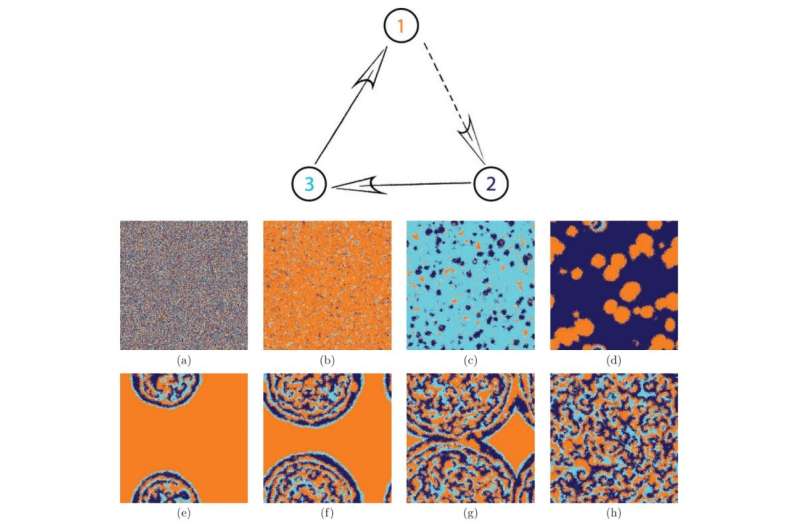July 4, 2019 feature
The rock-paper-scissors game and coexistence

In 1975, R.M. May and W.J. Leonard first used the rock-paper-scissors game to model ecological scenarios in which three species cyclically dominate each other: one species dominates a second species, the second species dominates a third species, and the third species dominates the first species. The game works well, for example, for modeling different strains of cyclically dominant E. coli bacteria.
Traditionally, the rock-paper-scissors model assumes that all three species have equal strength. But what if one of the species is weaker than the other two? Such a scenario may occur in nature, for example, due to seasonal variations that reduce the ability of a certain species to compete with other species.
In a new paper, associate professor Josinaldo Menezes, graduate student Tibério Pereira, and undergraduate student Bia Moura at the Federal University of the Rio Grande do Norte in Brazil have addressed this question by performing more than a million simulations of a rock-paper-scissors model in which one species attacks less than it is attacked. The model helps to explain how coexistence among different species is maintained in spite of the species' different strengths.
"The results tell us that the reason why species may coexist, even if one of them is weaker, is the special selection configuration of the rock-paper-scissors model," Pereira told Phys.org.
The model works somewhat differently than the original rock-paper-scissors model when implemented as a special case of the May-Leonard model. Individuals, which are placed on a grid, can carry out three possible interactions, no matter which of the three species they belong to. The three interactions are selection, mobility, and reproduction. Selection is like killing, in which an individual of one species can wipe out a neighboring individual of the species that it dominates. For mobility, an individual of one species can switch places with a neighboring individual of the species that it dominates, or move to a neighboring empty space. For reproduction, an individual of one species can populate an empty neighboring space with another individual of its species.
In the simulation, individuals of each species are randomly distributed on a grid. An individual is randomly selected, and then one of its eight neighboring sites (occupied or empty) is randomly selected. Next one of the three interactions (selection, mobility, or reproduction) is randomly chosen. The chosen individual carries out the interaction, if possible. In some cases, the interaction is not possible: for example, the neighboring site must be occupied by an individual of the correct species (the one being dominated) in order for selection to take place, and the neighboring site must be empty in order for reproduction to take place.
To make one species weaker than the other two, the researchers gave one species a lower probability of getting the selection interaction. The results of the simulations showed that, contrary to what might be expected, the weaker species does not necessarily die out. Instead, for some weakness levels, the weaker species initially dominates almost all of the territory. This happens because, since the weaker species selects (i.e., kills) fewer individuals of the species that it dominates, this species grows and, in turn, limits the growth of the third species. As this third species dominates the weaker species, its limited growth allows the weaker species to grow.
For these reasons, previous research has shown that the weaker species may always dominate, even in the long run. However, here the researchers found something different.
"We were surprised because the weaker species does not necessarily win the uneven rock-paper-scissors game, as it was known in the literature," Menezes said. "We found out that, in May-Leonard-type simulations, the winner species depends on the mobility and the strength of the weaker species."
Over time, new patterns appear showing exactly how the different species spatially coexist. In particular, spiral patterns emerge and travel like waves until they meet each other, at which point they result in all three species coexisting in small colonies. The spiral patterns—and resulting coexistence—are more likely to occur on larger grids, since this increases the mobility of all species and allows for the species to come in contact with each other.
"Beautiful spiral waves emerge when the lattice is almost dominated by one single species," said Moura. "The formation of spiral spatial patterns is entirely different from the standard rock-paper-scissors model. We expect that our results can be helpful to ecologists because they describe and quantify patterns which are crucial to understanding how such species coexist."
The results also revealed that coexistence has its limits: When the strength of the weaker species is less than approximately one-third of the strength of the other two species, the probability of coexistence greatly diminishes.
In the future, the researchers plan to investigate more complex scenarios, such as adaptive biological systems, where a species can change the interaction probabilities to guarantee its survival. They also plan to explore how biological interactions can balance the uneven relationships among species, as well as the effects of diseases and other predators.
"We aim to understand how a disease outbreak or a common predator mediation increases the chances of coexistence in the uneven rock-paper-scissors model," Menezes said.
More information: J. Menezes, B. Moura, and T.A. Pereira. "Uneven rock-paper-scissors models: Patterns and coexistence." EPL. DOI: 10.1209/0295-5075/126/18003
Journal information: Europhysics Letters (EPL)
© 2019 Science X Network





















